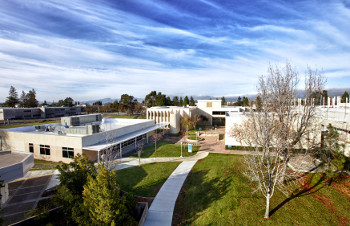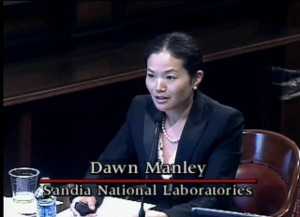 |
| January 31, 2012 | Volume 08 Issue 04 |
Designfax weekly eMagazine
Archives
Partners
Manufacturing Center
Product Spotlight
Modern Applications News
Metalworking Ideas For
Today's Job Shops
Tooling and Production
Strategies for large
metalworking plants
Wheels:
Sandia fuel expert says policy-makers need to get real, 'flex'-ible

Research conducted at Sandia's Combustion Research Facility, seen here and located on the grounds of the new Livermore Valley Open Campus (LVOC) in California, can continue to improve engine performance and efficiencies. [Photo by Randy Wong]
A transportation fuels expert from Sandia National Laboratories says policy-makers should consider such practical issues as the number of gas stations selling ethanol and how long it takes to get new transportation technologies to market as they introduce aggressive federal and state energy policies.
"Policy-makers need to have ways to think about the evolution from the current state of transportation energy to the desired future state," Dawn Manley said. "It is one thing to set aggressive targets on emission reductions, but you need to examine options for reaching desired future states in order to get there," she told California's Senate Transportation and Housing Committee late in October last year.
State lawmakers are examining the long-term viability of available fuels to meet the state's transportation demands, particularly those related to AB 32, a much-publicized California law that aims to reduce greenhouse gas emissions to 1990 levels.
According to the state Air Resources Board (ARB), which is implementing AB32, transportation accounts for 38% of greenhouse gas emissions in the state, hence the committee's focus on transportation fuels.
As an example of the difficulties that can arise when trying to execute new energy goals, Manley pointed to the Renewable Fuels Standard, a federal requirement that sets targets for biofuel production and volume. Specifically, a potential mismatch between the amount of ethanol biofuel that would be produced and the infrastructure to both absorb and distribute it could produce delays.
Currently, only 3% to 5% of the U.S. transportation fleet is composed of flex-fuel vehicles, which can operate on gasoline blends containing up to 85% ethanol (E85). About 2,400 gas stations in the U.S. – only a fraction of the 160,000 gas stations in the country – can dispense E85.
Two possible solutions are to have either higher blend requirements for all vehicles or more flex-fuel vehicles that can accept up to 85% ethanol, she said.
Even the seemingly modest policy change of going from 10% to 15% ethanol (approved last year) required waivers from the Environmental Protection Agency, Manley said. Also necessary was testing to demonstrate that higher blends are safe and free from higher emissions, and education of consumers who need to know when and how to use E15 ethanol.

Sandia's Dawn Manley, who testified in front of the State of California's Senate Transportation and Housing Committee, urges policy-makers to consider practical issues when enacting aggressive transportation energy policies. [Photo courtesy: The California Channel]
The proposed changes in ethanol policies, she said, are just one example of how a shift to advanced transportation technologies such as electric vehicles, fuel cells, and other biofuels pose enormous challenges.
Many in the transportation policy community want electric vehicles to become a standard in the U.S. transportation fleet. But, even if the assertion proves true that a vast majority of vehicles in the year 2050 will use some form of electrification, Manley echoed a recent op-ed article in the Washington Post (authored by Bob Carling, director of Sandia's Transportation Energy Center) and reminded the committee that most of those vehicles likely will still be using a combination of electric and combustion engines since an all-battery-powered vehicle fleet is unlikely by then.
"We need to realize that there is still much to be gained with the combustion engine," Manley said. "Even with all the exciting new technologies out there, a good chunk of electric vehicles are still going to be making use of the combustion engine."
She also emphasized that speed and scale are key in terms of advanced technology development, since it takes 15 to 20 years to change over the transportation fleet. "We all tend to think that hybrids are a mature transportation technology, but the fact is that they still only make up about 5% of all vehicle sales today," she said. "We still have a long way to go."
Manley also reflected on a recent visit to China and suggested that decision-makers in the U.S. can learn some lessons from their counterparts in Asia.
"When making decisions about transportation energy investments and technology development, the Chinese have described their strategy in terms of points, lines, and areas," she explained. "'Points' refers to dense urban areas, and they consider the kinds of vehicles that will make the most sense there. ‘Lines' are what connect those urban areas, so the Chinese think about the transportation strategies that are most effective in doing that. Finally, ‘areas' are the broader, rural and agricultural regions of the country, so again, they look at the unique transportation needs in these areas and build their strategies around them."
No one technology or policy will fit every transportation need, Manley said.
About Sandia
Sandia National Laboratories is a multiprogram laboratory operated and managed by Sandia Corporation, a wholly owned subsidiary of Lockheed Martin Corporation, for the U.S. Department of Energy's National Nuclear Security Administration.
Source: Sandia
Published January 2012
Rate this article
View our terms of use and privacy policy
